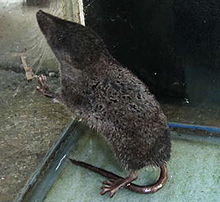| Japanese water shrew | |
|---|---|

| |
|
Scientific classification
| |
| Domain: | Eukaryota |
| Kingdom: | Animalia |
| Phylum: | Chordata |
| Class: | Mammalia |
| Order: | Eulipotyphla |
| Family: | Soricidae |
| Genus: | Chimarrogale |
| Species: | C. platycephalus
|
| Binomial name | |
| Chimarrogale platycephalus
Temminck, 1842
| |

| |
| Japanese water shrew range | |
The Japanese water shrew (Chimarrogale platycephalus), also called the flat-headed water shrew, is a species of mammal in the family Soricidae. It is endemic to Japanese Islands, Honshu and Kyushu. They are considered extinct in Shikoku. [2]
Description
The Japanese water shrew grows to a length of about 11 to 14 cm (4 to 6 in) long with a tail length of 8 to 12 cm (3 to 5 in) and weight of 25 to 63 grams (0.88 to 2.22 oz). The dense short fur on the head, back and sides is greyish-black. The underparts are dirty white and are sharply demarcated from the dorsal surface. Sometimes they are tinged with rusty brown or occasionally are entirely dark grey. There is a white spot just behind the eye and often another near the small, rounded ear which is nearly hidden in the fur. The nose is black and the snout long and tapering.
The Japanese water shrew inhabits mountain streams, small rivers and ponds, preying on benthic organisms, such as aquatic insects, crabs, shrimp, and small fish. [2]
See also
References
- ^ Cassola, F. (2016). "Chimarrogale platycephalus". IUCN Red List of Threatened Species. 2016: e.T40615A22282290. doi: 10.2305/IUCN.UK.2016-2.RLTS.T40615A22282290.en. Retrieved 12 November 2021.
- ^ a b Yamazaki, Haruka; Sekiya, Tomohiro; Nagayama, Shun; Hirasawa, Kei; Tokura, Keita; Sasaki, Akio; Ichiyanagi, Hidetaka; Tojo, Koji (2020-08-01). "Development of microsatellite markers for a soricid water shrew, Chimarrogale platycephalus, and their successful use for individual identification". Genes & Genetic Systems. 95 (4): 201–210. doi: 10.1266/ggs.20-00017.
-
 Media related to
Chimarrogale platycephalus at Wikimedia Commons
Media related to
Chimarrogale platycephalus at Wikimedia Commons
| Chimarrogale platycephalus | |
|---|---|
|
| This article about a red-toothed shrew is a stub. You can help Wikipedia by expanding it. |
